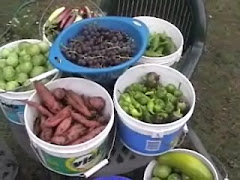
 In previous years we have relied upon an electric dehydrator to dry late season tomatoes, apples, pears, plums, tomatillos, elderberries and other fall crops. When our electric dehydrator broke in 2010 we re-purposed the trays and using a cardboard box as a makeshift air tunnel proceeded to use the hot air blowing out of our pellet stove to finish the task. It worked so good that I built a more permanent device to be used this past fall.
In previous years we have relied upon an electric dehydrator to dry late season tomatoes, apples, pears, plums, tomatillos, elderberries and other fall crops. When our electric dehydrator broke in 2010 we re-purposed the trays and using a cardboard box as a makeshift air tunnel proceeded to use the hot air blowing out of our pellet stove to finish the task. It worked so good that I built a more permanent device to be used this past fall.Our pellet stove dehydration unit #2 works on the same principle as the cardboard model. Hot air flows into the wooden box and is routed up through re-purposed dehydrator trays slowly but very effectively drying the foods within. During the months of October, November, and again in the early spring we often prefer to use our pellet stove to heat the house leaving the wood stove for the colder winter months, so it was only logical for us to make better use of the stoves heat by rigging up a way to dry our foods as well.
It's hard to take a decent photo inside our house so bear with me as these pictures are a bit hard to look at. This picture shows the dehydrator butted up against our pellet stove while inside tomatoes are drying. The whole unit sits atop an old barbecue stand that helps bring it to the correct height an makes it easier to roll around.
 Here you can see the hole was cut just smaller than the round trays and a line was drawn so I could easily center them properly.
Here you can see the hole was cut just smaller than the round trays and a line was drawn so I could easily center them properly. Inside I attached a piece of sheet metal to help direct the airflow up into the trays rather than the corners of the box.
Inside I attached a piece of sheet metal to help direct the airflow up into the trays rather than the corners of the box. I put bumpers on the outside so the unit would not come into direct contact with the hot pellet stove and also added a drip tray to catch any liquids that might leak out as is prone to happen when drying tomatoes.
I put bumpers on the outside so the unit would not come into direct contact with the hot pellet stove and also added a drip tray to catch any liquids that might leak out as is prone to happen when drying tomatoes. Most of our dried goods are stored in glass jars. While tomatoes tend to lose their flavor after six months or so most fruits, corn, hot peppers, and beans will keep for years this way. Have you ever dried a tomatillo? It brings out a surprisingly sweet/tart flavor that we find most appealing, especially as an addition to our salads.
Most of our dried goods are stored in glass jars. While tomatoes tend to lose their flavor after six months or so most fruits, corn, hot peppers, and beans will keep for years this way. Have you ever dried a tomatillo? It brings out a surprisingly sweet/tart flavor that we find most appealing, especially as an addition to our salads.
OK then, back to dreaming about spring...





















